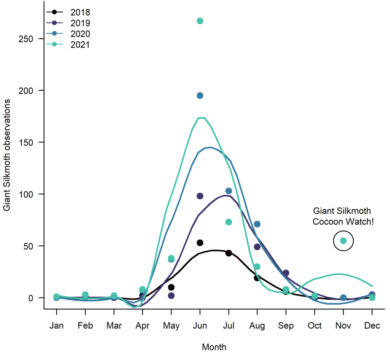The Vermont Giant Silk Moth Cocoon Watch has already been a great success. And there’s still more than two weeks left for you to contribute! Since the beginning of November, observers like you have been searching for these large cocoons and sharing with our project on iNaturalist. We’ve now tallied over 60 observations of four out of five Vermont species!
“We had few reports in previous years. But with this concerted effort, we are learning a lot more about where these moths pupate and rates of parasitism,” said Kent McFarland, Vermont Atlas of Life director.
Giant Silk Moths (Family Saturniidae) are recognized for their large size and beauty. Many species have reportedly declined for decades across the Northeast from the introduction of parasitic flies, pesticides, light pollution, and land use and climate change.

Late instar Cecropia Moth caterpillar starting to spin a cocoon with an infestation of Tachinid Fly eggs.
One possible explanation is dispersal of the “natural” insecticide Bacillus thuringiensis (Bt) against LD moths (Lymantria dispar). It most likely harms native insects as well. A study at the University of Massachusetts-Amherst seems to have found another culprit. Researchers there discovered that an introduced parasitic fly, Compsilura concinnata, attacks and kills giant silk moth caterpillars. The fly was repeatedly introduced from 1906 to 1986 to control some 13 pest species. Concerns about the effect on native moths by this fly were expressed as early as 1919. C. concinnata places its eggs on caterpillars. Once the caterpillar pupates, the tachinid fly larva will emerge and also pupate.
In addition to tachinid flies, giant silk moths are parasitized by a number of parasitic wasps too. We hope observers will return next year in late spring and early summer to the location of the cocoons they found and document if the moth or a parasite emerged.
Join a Workshop and Field Trip December 19
‘Stick season’ in Vermont provides us an opportunity to see cocoons of some of these amazing moths hanging in bushes and trees. Sign up and join us this Sunday, December 19 at noon to search for silk moth cocoons at Zebedee Wetland!
You will learn how to find and identify the cocoons of each silk moth species, learn how to share observations to our iNaturalist project, and spend an hour or two searching for cocoons. Please bring masks, your smart phone with the iNaturalist app (free from Google Play or the Apple App Store), and binoculars (to see those cocoons that are high in a tree) if you have them.








